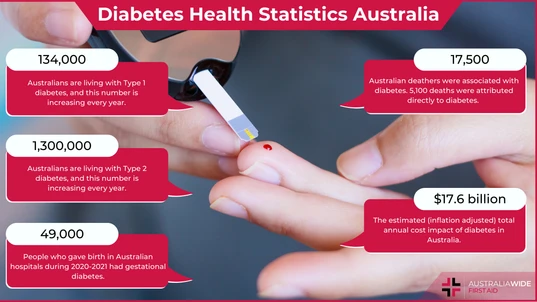Diabetes Health Statistics Australia

Disease

Diabetes is usually tested by using a blood glucose test.
Diabetes in Australia In the diverse landscape of global health challenges, diabetes stands as a formidable foe affecting millions of lives in Australia. With an aging population, increasingly sedentary lifestyles, and changing environmental factors, understanding the current state of diabetes in Australia becomes increasingly crucial for policymakers, healthcare professionals, and individuals alike. This article delves into the current diabetes health statistics in Australia, shedding light on the prevalence, impact, and trends of this condition within the nation. By examining key data and insights, we aim to provide a comprehensive overview of the diabetes landscape, allowing you to gain a deeper understanding of the challenges faced by Australians and the imperative need for proactive interventions.Types of Diabetes
The most common forms of diabetes in Australia are Type 1 Diabetes, Type 2 Diabetes, and Gestational Diabetes.Type 1 Diabetes
According to Diabetes Australia, Type 1 Diabetes is an autoimmune condition where a person’s pancreatic beta cells which produce insulin are destroyed due to an abnormally activated immune system. As insulin is involved in glucose uptake, a lack of insulin production means that glucose cannot enter cells to be converted to energy. Glucose build-up leads to dehydration from trying to remove the excess glucose through the urine as well as a build-up of the chemical substance, ketone bodies, from trying to burn fat to supply energy. The combination of dehydration and build-up of ketone bodies causes diabetic ketoacidosis (DKA) which is a life-threatening condition if not treated. Type 1 Diabetes onset can occur at any age however it is more common in people under the age of 30.Type 2 Diabetes
Diabetes Australia defines Type 2 Diabetes as a long-term condition where the body becomes resistant to the effects of insulin to manage blood glucose levels. In response to this, the pancreas attempts to produce an even greater amount of insulin to manage these levels. If this insulin overproduction response occurs over a long period of time, the pancreatic cells that produce insulin wear out. Type 2 Diabetes is typically developed in adults over the age of 45 years old, but recent statistics have seen an increase in children, adolescents, and young adults developing the condition.Gestational Diabetes
When a baby is growing and developing, the placenta produces hormones such as oestrogen and progesterone which blocks the actions of insulin, resulting in gestational diabetes. This insulin resistance appears during pregnancy but then normalises after giving birth. If the pregnant person already has insulin resistance, they may not be able to produce enough insulin to combat the combined effects of this. It is important to note that people with gestational diabetes do not pass diabetes onto their baby, and they can give birth to a healthy baby if the gestational diabetes is managed correctly throughout the pregnancy. All pregnant people are tested for Gestational Diabetes at 24-28 weeks of pregnancy, with those who have risk factors being tested earlier.
Diabetes health statistics
Diabetes Statistics - Overview
In 2020, the Australian Institute of Health and Welfare estimated that almost 1.3 million Australians were living with diabetes. These figures include those living with Type 1 Diabetes, Type 2 Diabetes, or other forms of diabetes except for Gestational Diabetes. It is important to note that it is difficult to accurately report the prevalence of diabetes in Australia as many Australians are living with undiagnosed Type 2 diabetes and this data only accounts for formal medical diagnoses. Increasing age is one of the key variables which increase the likelihood of diabetes, with 1 in 5 Australians between the ages of 80 and 84 living with the chronic condition. This is 30 times higher than those under the age of 40. The age-standardised rate of prevalence had increased by 1.9% since 2010, with diabetes also being more common in males compared to females.Prevalence of Type 1 Diabetes
Since 2000, 55,400 Australians have been diagnosed with Type 1 Diabetes, with approximately 13,000 of these cases occurring in children and young adults between the ages of 0 and 19 years old. There were 3,100 new diagnoses in 2020 alone, accounting for 12 diagnoses per 100,000 of the Australian population. The rate of new Type 1 Diabetes incidences has remained stable over the last 20 years, with between 11 to 13 new cases reported per 100,000 of the Australian population. In 2020, the AIHW reported that 65% of new Type 1 Diabetes diagnoses were for individuals aged between 0 to 29 years old. The highest rate of incidences fell within the age group of 10 to 14 years old, which was over two times higher than those aged 20 to 24. When adjusting for age, Type 1 Diabetes incidences were 1.4 times higher amongst males compared to females.Prevalence of Type 2 Diabetes
The AIHW collected data from the National Diabetes Services Scheme and Australia Paediatric Endocrine Group which showed that since 2000, 1.3 million Australians have been diagnosed with Type 2 Diabetes. The AIHW approximates this to be 60,000 diagnoses per year or an average of 166 new incidences per day. Of these incidences, 48,300 occurred in 2020, which is equal to 188 per day per 100,000 of the population in 2020. This data also showed that Type 2 Diabetes incidences increased with age, with those aged under 40 accounting for less than 3% of the total cases whilst almost 60% occurred in the 65 years and older age category. The overall prevalence of Type 2 Diabetes was higher in males, with incidence rates 1.3 times higher than in females. The highest prevalence among both men and women was between the ages of 80 to 84 years old.Gestational Diabetes Prevalence
According to the National Hospital Morbidity Database, approximately 49,000 pregnant Australians who gave birth in hospitals during 2020-21 had been diagnosed with gestational diabetes. When adjusting for age, incidence numbers have spiked significantly from 5.3% in 2000-01 to 18.9% in 2020-21. It is important to note that these figures may be disproportionate due to changes in diagnosis criteria as well as increasing exposure to risk factors. These can include:- Older maternal ages
- Higher rates of maternal overweight and obesity
- An increasing proportion of the population consisting of high-risk ethnic groups
Diabetes and Mortality Rates
The AIHW National Morbidity Database recorded 5,100 Australian deaths in 2020 due to diabetes. When including diabetes as an associated cause of death, this number increases significantly to 17,500 deaths. In 2010, diabetes was the 8th leading cause of death for men in Australia, causing 2.7% of deaths. In 2020, this increased to 3.5%, causing it to move up to the 7th leading cause of death in Australian men. In the same year, diabetes was the 9th leading cause of death for Australian women, accounting for 2.8% of all deaths. Similar to men, this number increased in 2020 to 3.0%, pushing it up to the 8th leading cause of death for women in Australia.Hospitalisations
In 2020-21, 1.3 million hospitalisations were a result of diabetes, accounting for 11% of all hospitalisations in Australia during this period. Type 2 Diabetes accounted for approximately 1.3 million of the recorded hospitalisations whilst Type 1 Diabetes was the cause of 64,600 hospitalisation cases. Of these cases, 4.7% recorded diabetes as the principal diagnosis whilst 95% of cases recorded diabetes as an additional diagnosis. In addition to this, many individuals with diabetes also required hospital procedures to manage or treat their diabetes. In 2020-21, 4,500 weight loss procedures were undertaken by individuals with Type 2 Diabetes whilst 5,300 Type 2 Diabetes patients undertook a lower leg amputation procedure.The Burden of Disease and Health Care Expenditure
The AIHW measures the burden of diseases in Disability-Adjusted Life Years (DALY), which is equivalent to one year of healthy life lost. In 2018, Type 2 Diabetes ranked as the 12th highest contributor to Australia’s total burden of disease, accounting for 112,500 DALY. This is equal to 4.5 DALY per 1,000 people in the Australian population. It was also found that 4.3% of the total burden could have been mitigated by individuals reducing their exposure to modifiable risk factors such as high blood plasma glucose levels. In the same year, Type 1 Diabetes contributed to 17,000 DALY, which is equal to 0.3 per 1,000 members of the Australian population. This number has remained stable since 2003. The Australian healthcare system recorded $3.0 billion of expenditure for diabetes in 2018-19, accounting for 2.3% of Australia’s total healthcare expenditure. The breakdown of the diabetes expenditure was:- 61% for Type 2 Diabetes
- 11% for Type 1 Diabetes
- 2.0% for Gestational Diabetes
- 26% for other forms of Diabetes
Conclusion
The examination of diabetes health statistics in Australia highlights the urgent need for comprehensive strategies to combat the growing burden of this chronic condition. The prevalence rates, impact on health, and economic implications underscore the importance of prevention, early detection, and effective management. It is crucial for policymakers, healthcare professionals, and individuals to work collaboratively in implementing targeted interventions, promoting healthy lifestyles, and investing in healthcare resources. By addressing the diabetes epidemic head-on, Australia can pave the way for a healthier future, where the impact of diabetes is minimised, and individuals can lead fulfilling lives free from the constraints of this pervasive disease.
Originally published at
https://www.australiawidefirstaid.com.au/resources/diabetes-health-statistics-australia
as part of the Australia Wide First Aid Articles Library









